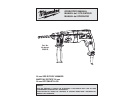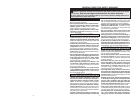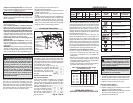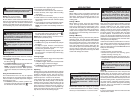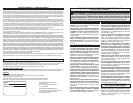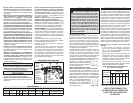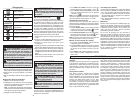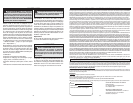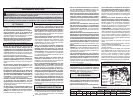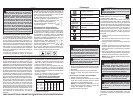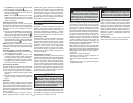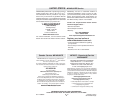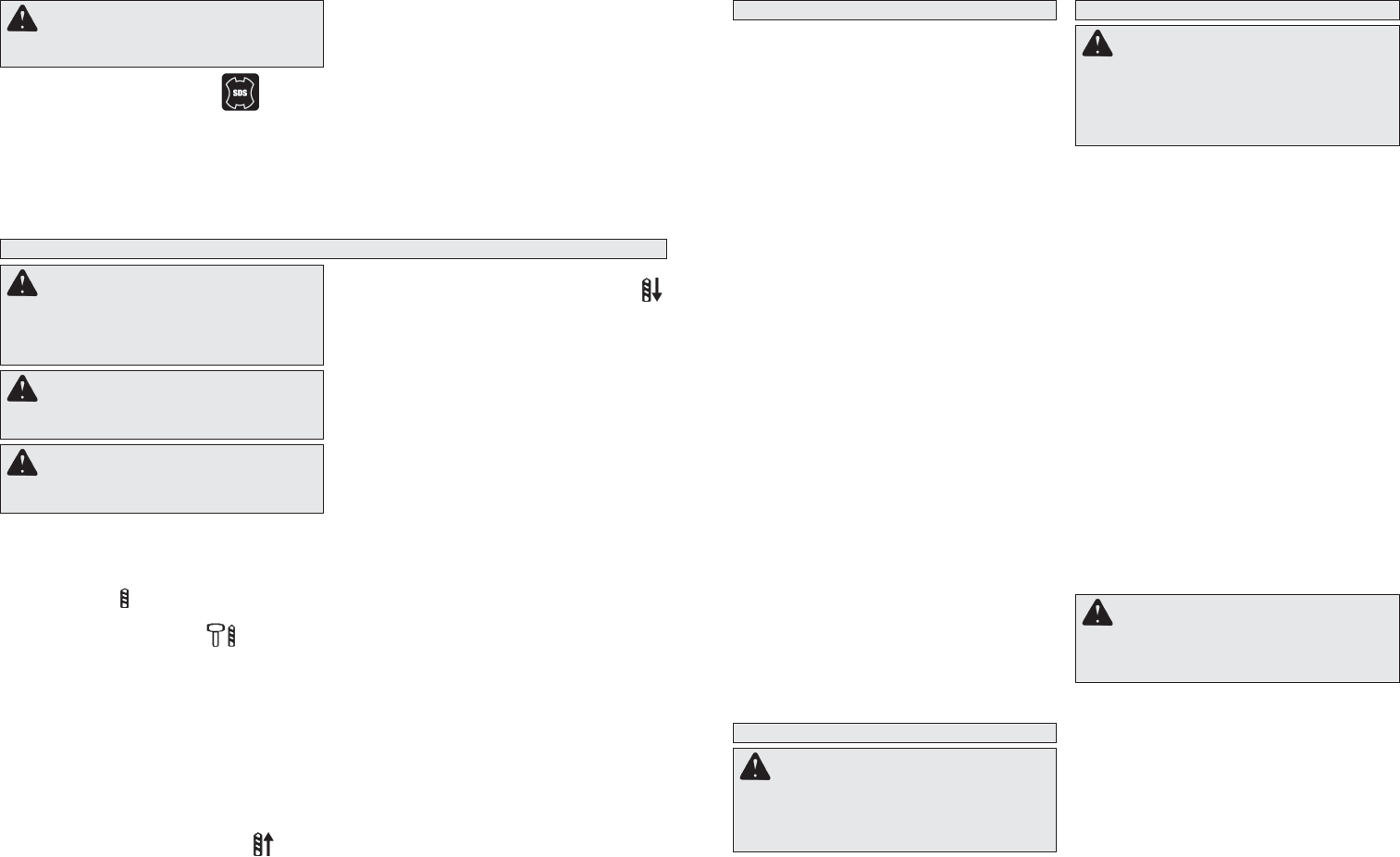
6
7
OPERATION
WARNING To reduce the risk of injury,
always unplug tool before attaching or remov-
ing accessories or making adjustments. Use
only specifi cally recommended accessories.
Others may be hazardous.
WARNING To reduce the risk of injury,
keep hands and cord away from the bit and
all moving parts.
WARNING To reduce the risk of injury,
do not grasp the bit while the chuck is rotating
or while the bit is falling from the chuck.
Installing Drill Bits and Chisels
NOTE: Only use accessories
with SDS or SDS Plus shanks.
Be sure that the shank of the bit is clean. Dirt par-
ticles may cause the bit to line up improperly. Do not
use bits larger than the maximum recommended
capacity of the drill because gear damage or mo-
tor overloading may result. For best performance,
WARNING To reduce the risk of injury,
wear safety goggles or glasses with side
shields.
Selecting Action
MILWAUKEE Hammer-Drills have two settings:
drilling and hammer-drilling.
1. For drilling, turn the hammer-drill lever towards
the drill symbol
.
2. For hammer-drilling, turn the hammer-drill lever
towards the hammer symbol .
NOTE: To engage the hammering mechanism,
maintain pressure on the bit. When pressure
on the bit is released, the hammering action will
stop.
Using Forward/Reverse Lever
The forward/reverse lever can only be adjusted
when the trigger is not pressed. Always allow the
motor to come to a complete stop before using the
forward/reverse lever.
1. For forward (clockwise) rotation, push the con-
trol switch to the left side of the tool
. Check
the direction of rotation before use.
be sure that the bit is properly sharpened and the
shank is lightly greased before use.
1. Insert the bit or chisel into the nose of the tool.
2. Rotate bit slowly until it aligns with the locking
mechanism.
3. Push bit into tool until it locks.
4. Check that the bit is locked properly; it should
be possible to pull the bit back and forth slightly
(about 1/4”).
5. To remove bits and chisels, pull bit holder release
collar toward the rear of tool and remove bit.
NOTE: Use caution when handling hot bits and
chisels.
2. For reverse (counterclockwise) rotation, push
the control switch to the right side of the tool
.
Check direction of rotation before use.
NOTE: When hammer-drilling, use the tool in for-
ward rotation (clockwise) only.
Starting, Stopping and Controlling Speed
1. To start the tool, grasp the handle fi rmly and pull
the trigger.
2. To vary the speed, increase or decrease the
pressure on the trigger. The further the trigger
is pulled, the greater the speed.
3. To stop the tool, release the trigger. Make sure
the tool comes to a complete stop before laying
the tool down.
Locking Trigger
The lock button holds the trigger in the ON position
for continuous full speed use.
1. To lock the trigger, hold in the lock button while
pulling the trigger. Release the trigger.
2. To unlock the trigger, pull the trigger and release.
The lock button will pop out.
Operating
Position the tool, grasp the handles fi rmly and pull
the trigger. Always hold the tool securely using both
handles to maintain control. This tool has been
designed to achieve top performance with only
moderate pressure. Let the tool do the work.
If the speed begins to drop off when drilling large
or deep holes, pull the bit partially out of the hole
while the tool is running to help clear dust. Do not
use water to settle the dust since it will clog the bit
fl utes and tend to make the bit bind in the hole. If
the bit should bind, a built-in, non-adjustable slip
clutch prevents the bit from turning. If this occurs,
stop the tool, free the bit and begin again.
APPLICATIONS
MAINTENANCE
WARNING To reduce the risk of
injury, always unplug your tool before
performing any maintenance. Never disas-
semble the tool or try to do any rewiring
on the tool’s electrical system. Contact a
MILWAUKEE service facility for ALL repairs.
Maintaining Tools
Keep your tool in good repair by adopting a regular
maintenance program. Before use, examine the
general condition of your tool. Inspect guards,
switches, tool cord set and extension cord for
damage. Check for loose screws, misalignment,
binding of moving parts, improper mounting, bro-
ken parts and any other condition that may affect
its safe operation. If abnormal noise or vibration
occurs, turn the tool off immediately and have the
problem corrected before further use. Do not use a
damaged tool. Tag damaged tools “DO NOT USE”
until repaired (see “Repairs”).
Under normal conditions, relubrication is not neces-
sary until the motor brushes need to be replaced.
After six months to one year, depending on use,
return your tool to the nearest MILWAUKEE service
facility for the following:
• Lubrication
• Brush inspection and replacement
• Mechanical inspection and cleaning (gears,
spindles, bearings, housing, etc.)
• Electrical inspection (switch, cord, armature, etc.)
• Testing to assure proper mechanical and electri-
cal operation
WARNING To reduce the risk of injury,
electric shock and damage to the tool, never
immerse your tool in liquid or allow a liquid
to fl ow inside the tool.
Cleaning
Clean dust and debris from vents. Keep the tool
handles clean, dry and free of oil or grease. Use
only mild soap and a damp cloth to clean your tool
since certain cleaning agents and solvents are
harmful to plastics and other insulated parts. Some
of these include: gasoline, turpentine, lacquer thin-
ner, paint thinner, chlorinated cleaning solvents,
ammonia and household detergents containing
ammonia. Never use fl ammable or combustible
solvents around tools.
Repairs
If your tool is damaged, return the entire tool to the
nearest service center.
Drilling in Wood, Composition Materials and
Plastic
When drilling in wood, composition materials and
plastic, select the drill operating mode. Start the
drill slowly, gradually increasing speed as you
drill. Select low speeds for plastics with a low
melting point.
Drilling in Metal
When drilling in metal, select the drill operating
mode. Use high speed steel twist drills or hole
saws. Use a center punch to start the hole. Lubri-
cate drill bits with cutting oil when drilling in iron
or steel. Use a coolant when drilling in nonferrous
metals such as copper, brass or aluminum. Back
the material to prevent binding and distortion on
breakthrough.
Drilling in Masonry
When drilling in masonry, select the rotary hammer
operating mode. Use high speed carbide-tipped
bits. Drilling soft masonry materials such as cinder
block requires little pressure. Hard materials like
concrete require more pressure. A smooth, even
fl ow of dust indicates the proper drilling rate. Do
not let the bit spin in the hole without cutting. Do
not use water to settle dust or to cool bit. Do not
attempt to drill through steel reinforcing rods. Both
actions will damage the carbide.
ACCESSORIES
For a complete listing of accessories refer to your
MILWAUKEE Electric Tool catalog or go on-line
to www.milwaukeetool.com. To obtain a catalog,
contact your local distributor or a service center.
WARNING To reduce the risk of injury,
always unplug the tool before attaching or
removing accessories. Use only specifi cally
recommended accessories. Others may be
hazardous.



